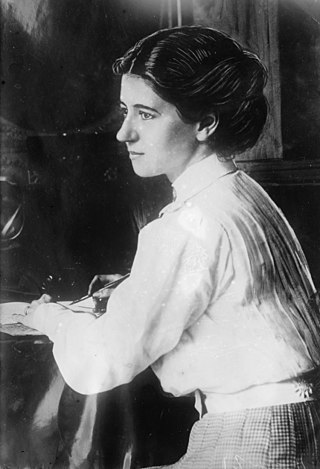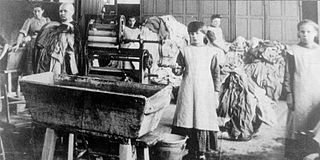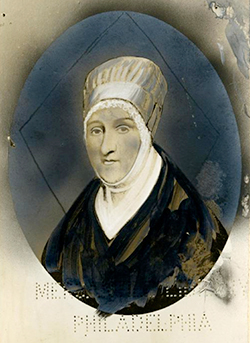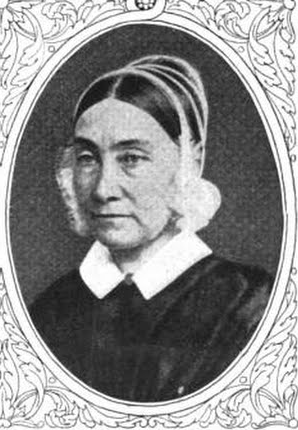
Elizabeth Fry, sometimes referred to as Betsy Fry, was an English prison reformer, social reformer, philanthropist and Quaker. Fry was a major driving force behind new legislation to improve the treatment of prisoners, especially female inmates, and as such has been called the "Angel of Prisons". She was instrumental in the 1823 Gaols Act which mandated sex-segregation of prisons and female warders for female inmates to protect them from sexual exploitation. Fry kept extensive diaries, in which she wrote explicitly of the need to protect female prisoners from rape and sexual exploitation.

Magdalene asylums, also known as Magdalene laundries, were initially Protestant but later mostly Roman Catholic institutions that operated from the 18th to the late 20th centuries, ostensibly to house "fallen women". The term referred to female sexual promiscuity or sex workers, young women who became pregnant outside of marriage, or young girls and teenagers who did not have familial support. They were required to work without pay apart from meagre food provisions, while the institutions operated large commercial laundries, serving customers outside their bases.

Pennsylvania Hospital is a private, non-profit, 515-bed teaching hospital located at 800 Spruce Street in Center City Philadelphia, The hospital was founded on May 11, 1751 by Benjamin Franklin and Thomas Bond, and was the second established public hospital but had the first surgical ampitheatre in the United States. and its first medical library. It is part of the University of Pennsylvania Health System.

William White was the first and fourth Presiding Bishop of the Episcopal Church of the United States, the first bishop of the Diocese of Pennsylvania (1787–1836), and the second United States Senate Chaplain. He also served as the first and fourth President of the House of Deputies for the General Convention of the Episcopal Church.

The Institute for Colored Youth was founded in 1837 in Philadelphia, Pennsylvania, United States. It became the first college for African-Americans in the United States, although there were schools that admitted African Americans preceding it. At the time, public policy and certain statutory provisions prohibited the education of blacks in various parts of the nation and slavery was entrenched across the south. It was followed by two other black institutions— Lincoln University in Pennsylvania (1854), and Wilberforce University in Ohio (1856). The second site of the Institute for Colored Youth at Ninth and Bainbridge Streets in Philadelphia was added to the National Register of Historic Places in 1986. It is also known as the Samuel J. Randall School. A three-story, three-bay brick building was built for it in 1865, in the Italianate-style After moving to Cheyney, Pennsylvania in Delaware County, Pennsylvania its name was changed to Cheyney University.

Thomas Story Kirkbride was a physician, alienist, hospital superintendent for the Institute of the Pennsylvania Hospital, and primary founder of the Association of Medical Superintendents of American Institutions for the Insane (AMSAII), the organizational precursor to the American Psychiatric Association. Along with Benjamin Rush he is considered to be the father of the modern American practice of psychiatry as a specific medical discipline. His directive and organization of institutions for the insane were the gold-standard of clinical care in psychiatry throughout the 19th century.

The Congregation of Our Lady of Charity of the Good Shepherd, also known as the Sisters of the Good Shepherd, is a Catholic religious order that was founded in 1835 by Mary Euphrasia Pelletier in Angers, France. The religious sisters belong to a Catholic international congregation of religious women dedicated to promoting the welfare of women and girls.

Violet Oakley was an American artist. She was the first American woman to receive a public mural commission. During the first quarter of the 20th century, she was renowned as a pathbreaker in mural decoration, a field that had been exclusively practiced by men. Oakley excelled at murals and stained glass designs that addressed themes from history and literature in Renaissance-revival styles.
White-Williams Scholars is an education charity that assists underprivileged children in the Philadelphia, Pennsylvania area. It is one of the oldest charitable organizations in the United States. In 2011, White-Williams Scholars merged with Philadelphia Futures, another education organization in the area.

Lucretia Mott was an American Quaker, abolitionist, women's rights activist, and social reformer. She had formed the idea of reforming the position of women in society when she was amongst the women excluded from the World Anti-Slavery Convention held in London in 1840. In 1848, she was invited by Jane Hunt to a meeting that led to the first public gathering about women's rights, the Seneca Falls Convention, during which the Declaration of Sentiments was written.
Lady Arabella Fitzmaurice Denny (1707–1792) was an Irish philanthropist, and founder of the Magdalen Asylum for Protestant Girls in Leeson Street, Dublin in 1765.

Caroline White was an American philanthropist and anti-vivisection activist. She co-founded the Pennsylvania Society for the Prevention of Cruelty to Animals (PSPCA) in 1867, founded its women's branch (WPSPCA) in 1869, and founded the American Anti-Vivisection Society (AAVS) in 1883.

The Philadelphia Female Anti-Slavery Society (PFASS) was founded in December 1833, a few days after the first meeting of the American Anti-Slavery Society, and dissolved in March 1870 following the ratification of the 14th and 15th Amendments to the U.S. Constitution. It was founded by eighteen women, including Lucretia Mott, Mary Ann M'Clintock, Margaretta Forten, her mother Charlotte, and Forten's sisters Sarah and Harriet.

Edna Buckman Kearns was a suffrage activist who worked on the 1915 and 1917 New York campaigns for votes for women, as well as the National Woman's Party campaign for the passage and ratification of the 19th amendment to the US Constitution.

The Magdalene Laundries in Ireland, also known as Magdalene asylums, were institutions usually run by Roman Catholic orders, which operated from the 18th to the late 20th centuries. They were run ostensibly to house "fallen women", an estimated 30,000 of whom were confined in these institutions in Ireland.

Deborah Norris Logan was an American Quaker historian and memoirist, and wife of politician George Logan.

The Glasgow Magdalene Institution was an asylum in Glasgow, Scotland, initially started in 1812 and was open until 1958.

Sarah Pugh was an American abolitionist, activist, suffragist, and teacher. She was involved with promoting the free produce movement, including a boycott on sugar produced by slave labor. She was a leader of the Philadelphia Female Anti-Slavery Society from its earliest days in 1835 until it closed in 1870. Along with Lucretia Mott, Pugh was one of the delegates to the World Anti-Slavery Convention in London who were denied their seats because they were women.
Emma Sheppard (1813–1871) was an English writer and workhouse reformer in Frome, who became widely known for her book Sunshine in the Workhouse and for efforts, both local and national, to improve conditions for inmates.
Anne Parrish (1760–1800) was an American Quaker philanthropist. Following the 1793 yellow fever epidemic in Philadelphia, she devoted herself to philanthropy and co-founded a women's relief society for the poor. The Female Society for the Relief of the Distressed, founded in 1795, was one of the first charitable women's organizations in the United States. Parrish also establish a free school for girls in her home in 1796. The school expanded over the years, later becoming the Aimwell School which lasted until 1923.
De Cunzo, Lu Ann. Reform, Respite, Ritual: An Archaeology of Institutions; The Magdalen Society of Philadelphia, 1800-1850, published in Historical Archeology, volume 29, no. 3 (1995).















